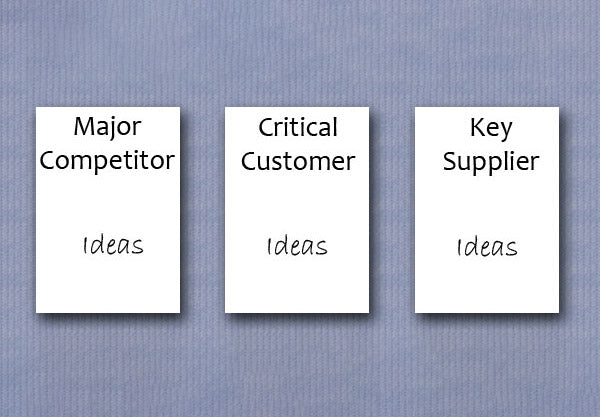Purpose
While brainstorming, sometimes people may feel reluctant to voice their ideas especially if they want to raise a concern or highlight a problem. This is particularly common when senior staff or managers are present and no one wants to look bad by saying something negative about their boss’s suggestions. In addition, people generally prefer not to be the messenger of bad news and would rather leave it for someone else to highlight the issue. Unfortunately, this leads to groupthink where people end up agreeing with each other rather than thinking of better alternatives or solutions.
The rolestorming technique proposed by Rick Griggs in 1980s aims to solve this problem by giving an opportunity to participants to adopt different roles while going through the brainstorming session.
Objective
Adopt different roles and present your ideas and solutions to the problem as if you are somebody else.
What You Need
- Blank cards
Setup
- Identify a problem for the purpose of this brainstorming exercise.
- Explain that during the brainstorming session participants will adopt a particular role of their choice and present their ideas though that specific perspective.
- Ask delegates to identify their roles and write it on a blank card.
- The roles can be anything so long as the particular person is not present in the brainstorming session. The role does not have to be directly related to the problem. Examples of roles are:
- Your old boss
- A major competitor
- A famous CEO in the industry
- A friend
- A member of your family
- A difficult but important customer
- A critical supplier
- A historic character
- A teacher or mentor
- Allow delegates to think about their roles for about 2 minutes to get into character. Ask them to consider the following questions:
- What is the perspective of this character?
- How would this person see the problem?
- What is the underlying attitude and mentality of this character?
- Just to make sure that the brainstorming session goes smoothly, highlight the fact that the characterisations should not be disrespectful. The aim is just to see the problem from a different point of view.
- Ask everyone to get into their character and brainstorm solutions. While stating their ideas they should use statements such as, “This person would suggest…” and “My character thinks…” to highlight the fact the idea is presented from a different perspective.
- You can use Round-Robin brainstorming technique or choose other brainstorming techniques at this point to combine this technique with other types of brainstorming methods.
- After 10 minutes ask the delegates to choose another role and write it on a new blank card.
- Follow with a new 10 minutes session to brainstorm for solutions using the new characters.
- Repeat as necessary.
- Follow with a general discussion on the brainstorming technique.
Timing
Explaining the Exercise: 2 minutes
Activity: (2 min getting into character + 10 min brainstorm) * N = 24 minutes for two rounds
Group Feedback: 10 minutes
Discussion
How effective was the Rolestorming technique? Were participants able to contribute ideas that they would not have done normally? Which roles were common or most effective?
Comments
By Leslie @ Wednesday, March 20, 2013 9:24 PM
This exercise was extremely successful in generating creative ideas and unique perspectives for solving the problem at hand. Participants enjoyed thinking about the challenges and opportunities from a different view and found themselves coming up with insights and options they hadn't previously thought of. The Rolestorming technique proved to be a great tool for our group and we expect to use it often going forward.
Soft Skills Training Materials
Get downloadable training materials
Online Train the Trainer Course:
Core Skills
Learn How to Become the Best Trainer in Your Field
All Tags
Training Resources for You

Course Design Strategy
Available as paperback and ebook

Free Training Resources
Download a free comprehensive training package including training guidelines, soft skills training activities, assessment forms and useful training resources that you can use to enhance your courses.

Our Comprehensive Guide to Body Language

Train the Trainer Resources
Get Insights - Read Guides and Books - Attend Courses
Training Materials
Get downloadable training materials on: Management Training, Personal Development, Interpersonal Development, Human Resources, and Sales & Marketing














Leave a comment
All comments are moderated before being published.
This site is protected by hCaptcha and the hCaptcha Privacy Policy and Terms of Service apply.